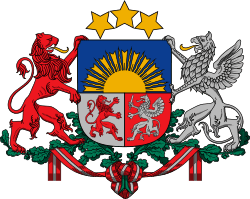Vends (Latvia)
The Vends (Russian: Венды) were a small tribe that lived in the 12th to 16th centuries in the area around the town of Wenden (now Cēsis) in present-day north-central Latvia.
According to Livonian Chronicle of Henry prior to their arrival in the area of Wenden in the 12th century, the Vends were settled in Ventava county (Latin: Wynda)[1] by the Venta River near the present city of Ventspils in western Latvia. Their proximity to more numerous Finnic and Baltic tribes inclined the Vends to ally with the German crusaders, who began building a stone castle near the older Vendian wooden fortress in 1207. The castle of Wenden later became the residence of the Master of the Livonian Order. The last known record of the Vends' existence as a distinct entity dates from the sixteenth century.
Origin
The Henry of Latvia made the first surviving mention of the Vends as they were chased away from Courland and Christianized by Germans during Livonian Crusade of 1198-1290.[2] Traditionally researchers believe that Vends spoke a Finnic language and were related to the neighboring Livonians and the Votes. Sometimes they are associated with the Western Slavic Wends.[3]
Flag of Latvia
Vends may have a connection with the national flag of Latvia. The Rhyme Chronicle of Livonia (Livländische Reimchronik) states that in 1290 when the local militia was recruited to defend Riga, they came from Wenden with "a Latvian red banner crossed by white, in the manner of the Vends/of the Wenden" (nâch wendischen siten).[4]
See also
References
- ↑ Heinrici Chronicon Livoniae, X.14.: Wendi autem humiles erant eo tempore et pauperes utpote a Winda repulsi, qui est fluvius Curonie, et habitantes in Monte Antiquo, iuxta quem 1206.
- ↑ Bojtár, Endre (1999). Foreword to the Past. Central European University Press. p. 87. ISBN 9789639116429.
- ↑ В.В. Седов. Славяне в древности. Мocквa, 1994 (Summary in English)
- ↑ Livlädische Reimchronik: die quâmen hovelîchen dar / mit einer banier rôtgevar,/ daß was mit wîße durch gesniten/ hûte nâch wendischen siten./ Wenden ist ein burc genant,/ von den die banier wart bekant,/ und ist in Letten lant gelegen,/ dâ die vrowen rîtens pflegen/ nâch den siten, als die man./ vor wâr ich ûch daß sagen kan,/ die banier der Letten ist. (09223-09233)
